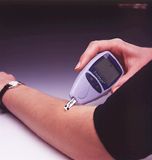"Diabetes"
(Gr. "passing through") is a general term for diseases marked by excessive urination. The
term, in general usage, usually refers to one type, arguably the most common form, diabetes
mellitus, (although there are other forms, such as
"diabetes insipidus"
with substantial sufferers.)
 "Mellitus" is a chronic
disorder of carbohydrate metabolism. It is marked by
hyperglycemia
and
glycosuria
and results from inadequate production or use of insulin. Orthodoxy divides mellitus into
two groups, based on their
"syndromes, Type I, insulin dependent diabetes (IDDM), and Type II, non-insulin-dependent diabetes
mellitus (NIDDM). In type I, the patient secretes no insulin, such that insulin must be
administered to counter this deficiency. In the past, this form of diabetes was called
"brittle diabetes,
juvenile-onset, or ketotic. In type II, insulin is produced, but
exogenous
insulin is still needed to control
hyperglycemia.
Former terms for this type were maturity-onset, nonketotic, and stable diabetes. Type II
occurs with far greater frequency than type I and is most common among those over 40
years of age.
"Mellitus" is a chronic
disorder of carbohydrate metabolism. It is marked by
hyperglycemia
and
glycosuria
and results from inadequate production or use of insulin. Orthodoxy divides mellitus into
two groups, based on their
"syndromes, Type I, insulin dependent diabetes (IDDM), and Type II, non-insulin-dependent diabetes
mellitus (NIDDM). In type I, the patient secretes no insulin, such that insulin must be
administered to counter this deficiency. In the past, this form of diabetes was called
"brittle diabetes,
juvenile-onset, or ketotic. In type II, insulin is produced, but
exogenous
insulin is still needed to control
hyperglycemia.
Former terms for this type were maturity-onset, nonketotic, and stable diabetes. Type II
occurs with far greater frequency than type I and is most common among those over 40
years of age.
 Symptoms: Some of the main symptoms are elevated blood glucose (hyperglycemia), excessive urine
production, excessive thirst, glucose in the urine, an increase in appetite, and itching,
frequently in the genital area. Insulin-dependent diabetes mellitus is an autoimmune disease
triggered by a nonspecific viral infection that inflames cells in the pancreas. Most common
of these infections are caused by rubella, mumps, or flu.
Symptoms: Some of the main symptoms are elevated blood glucose (hyperglycemia), excessive urine
production, excessive thirst, glucose in the urine, an increase in appetite, and itching,
frequently in the genital area. Insulin-dependent diabetes mellitus is an autoimmune disease
triggered by a nonspecific viral infection that inflames cells in the pancreas. Most common
of these infections are caused by rubella, mumps, or flu.
 Etiology: Type I is an autoimmune disease
triggered by nonspecific viral infections that inflame the pancreas. The most common
infections are caused by cytomegalovirus, mumps, flu, or rubella. Although the exact
mechanisn is still unclear, the inflammatory process seems to stimulate the beta cells to
produce slightly abnormal class I histocompatibility locus antigens (HLA). Lymphocytes
recognize these antigens as invasive and set about to destroy them, releasing more beta
cell proteins that can make additional HLA and stimulating an ongoing immune response that
eventually destroys all the beta cells producing insulin. The HLA's in the pancreas are
determined genetically. Because most patients with IDDM have HLA-DR3, HLA-DR4 or both,
the tendency to develop an autoimmune response and subsequent IDDM is considered hereditary.
IDDM may occur at any age but is usually diagnosed before age 30.
Etiology: Type I is an autoimmune disease
triggered by nonspecific viral infections that inflame the pancreas. The most common
infections are caused by cytomegalovirus, mumps, flu, or rubella. Although the exact
mechanisn is still unclear, the inflammatory process seems to stimulate the beta cells to
produce slightly abnormal class I histocompatibility locus antigens (HLA). Lymphocytes
recognize these antigens as invasive and set about to destroy them, releasing more beta
cell proteins that can make additional HLA and stimulating an ongoing immune response that
eventually destroys all the beta cells producing insulin. The HLA's in the pancreas are
determined genetically. Because most patients with IDDM have HLA-DR3, HLA-DR4 or both,
the tendency to develop an autoimmune response and subsequent IDDM is considered hereditary.
IDDM may occur at any age but is usually diagnosed before age 30.

Diabetes
this page focuses primarily on the most common type: diabetes mellitus

he focus of our work at Alpha Omega Labs in the
diabetic area has been on undercutting the
acidosis associated with diabetes mellitus.
Called
"ketoacidosis",
or more specifically,
"diabetic
keratosis, orthodoxy has chosen to teach, to this point, that
ketoacidosis is the result of an absence of insulin. The
acidosis part seems correct, if you check the systemic
pH readings of diabetes sufferers, you consistently
find pH values well below 6.4.
 Alpha Omega dared to ask the
unthinkable, "What if the acidosis itself was causally connected
to pancreas inability to produce insulin?" ... or
"Could acidosis, as opposed to viral infections, be
a prime culprit in suppressing or destroying the pancreatic
beta cells that product insulin?" ... or
more directly, "If you treated acidosis as if it were a
leading contributor and not a by-product, and actually
corrected the problem, would blood glucose follow
and subsequently normalize?"
Alpha Omega dared to ask the
unthinkable, "What if the acidosis itself was causally connected
to pancreas inability to produce insulin?" ... or
"Could acidosis, as opposed to viral infections, be
a prime culprit in suppressing or destroying the pancreatic
beta cells that product insulin?" ... or
more directly, "If you treated acidosis as if it were a
leading contributor and not a by-product, and actually
corrected the problem, would blood glucose follow
and subsequently normalize?"
 Our findings, to date,
are a resounding, "Yes." Not only have we not found one
single case where HRx did not
quickly (within days) raise the pH of the diabetic to
ranges that were in the mid-6.0's,
but we have yet to find a case where the blood glucose
did not fall precipitously - normally from 200 mg/dl and higher
to levels that average around 120 mg/dl. This is an astonishing
finding that requires much additional research. Also, this
observation does little to either confirm or rule out
our initial theory. Whatever the physiological or
metabolic mechanisms employed, the fact is, some
of our test cases of "stable diabetes" claim that they
no longer need to take insulin. We feel this is an
encouraging start and further research may show that
pH control is a far better way of handling many
cases of diabetes mellitus than through insulin.
Our findings, to date,
are a resounding, "Yes." Not only have we not found one
single case where HRx did not
quickly (within days) raise the pH of the diabetic to
ranges that were in the mid-6.0's,
but we have yet to find a case where the blood glucose
did not fall precipitously - normally from 200 mg/dl and higher
to levels that average around 120 mg/dl. This is an astonishing
finding that requires much additional research. Also, this
observation does little to either confirm or rule out
our initial theory. Whatever the physiological or
metabolic mechanisms employed, the fact is, some
of our test cases of "stable diabetes" claim that they
no longer need to take insulin. We feel this is an
encouraging start and further research may show that
pH control is a far better way of handling many
cases of diabetes mellitus than through insulin.
 This product is available from our Virtual
Store. Our liberal
Money Back Guarantee applies.
This product is available from our Virtual
Store. Our liberal
Money Back Guarantee applies.


